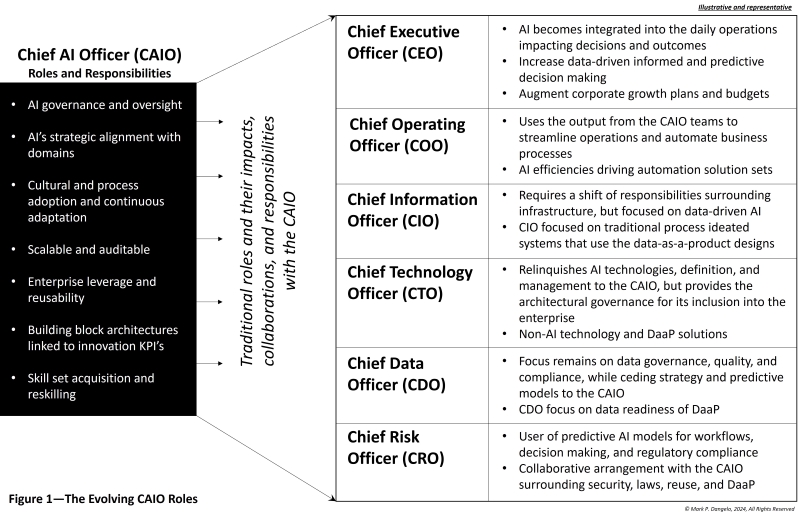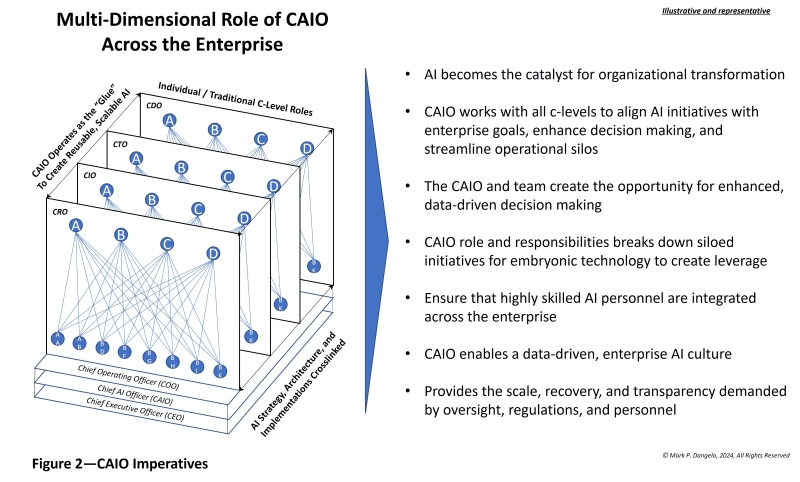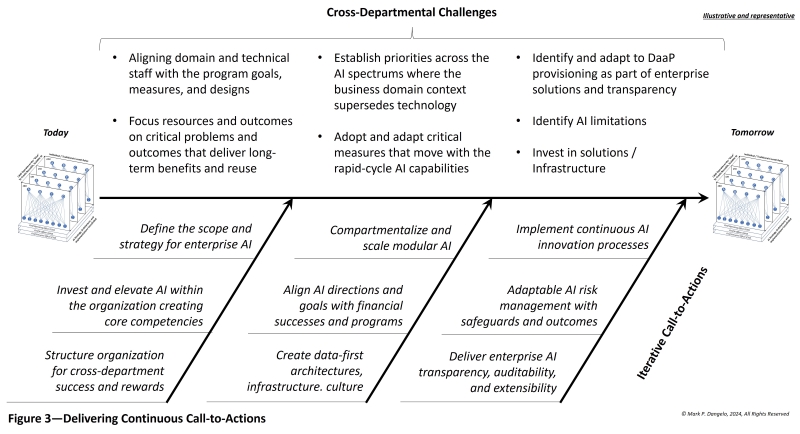The dilemma for boards of directors and executives is how to integrate rapidly iterating AI capabilities, and the answer for many: The emerging role of the Chief AI Officer
Across industry domains, supporting functions, and global economics, the impacts of the what, how, and why of artificial intelligence (AI) varies greatly. The last two years have shown that there is great interest, potential, and power in AI that has captured the imagination of consumers, regulators, and executives. And, while AI is well over 40 years old, it has been only during the last two years — with the release of generative AI (GenAI) and the publicly available ChatGPT platform —that the adoption wildfire has currently gotten underway.
The results reported by effectively integrating AI into corporate capabilities and culture have been extraordinary. According to Thomson Reuters 2024 Future of Professionals Report of the legal, risk, and tax & accounting industries, AI is significantly impacting the strategy of 94% of corporations, resulting in increasing investment in that space. Further, professionals within those industries said they expect more than half (56%) of their work to utilize AI within the next five years, whether through making current work more efficient, creating first drafts of work product, or automating jobs entirely with no need for review.
Yet, the news is not all positive. As AI technology emerges and grows in complexity, the failure rates of AI projects is nearly double that of traditional software investments (up to 80% of AI projects fail to meet key performance indicators (KPIs). Additionally, pilot programs are failing when brought into production due to lack of robustness, scalability, and event-driven adjustments (because of data volumes, variability, and velocity). There is also one critical, expensive asset that is beyond the one-off infrastructure, even beyond the software and beyond the data — the people and advanced skills necessary to identify, implement, and iterate AI solutions.
Integrating quickly changing AI capabilities
Yet the dilemma for board of directors and C-Suite level executives is how to integrate rapidly iterating AI capabilities. Where will AI impact the organization’s existing initiatives and budgets? What designs and audit approaches will deliver transparent regulatory compliance? And most importantly, who will be tasked with ensuring adoption, consistency, and adaptability?
So given the potential, the current challenges, and the traditional governance and oversight methods, what should be the plan-of-attack to define, manage, integrate, and retire AI capabilities, which are measured in weeks and months — not years? Whereas the why of AI oversight is increasingly obvious — leverage, reusability, risks, expenses, context, staffing, and expertise — the details surrounding the tasks, activities, and responsibilities are emerging and can be opaque depending on the organization’s size, strategy, and innovation culture.
However, today’s innovative leaders within large, diverse enterprises are creating an emerging role (the who) to manage the complexities mentioned above — the Chief AI Officer (CAIO). It is not a traditional C-Suite role that often derives its mandates and responsibilities vertically in support of horizontal positions such as the CEO, COO, or CFO. Indeed, examples of vertical support C-Suite level roles include the chief data officer (CDO), the chief marketing officer (CMO), the chief information officer (CIO), and the chief technology officer (CTO), which are often hemmed by definitive functions, methods, or divisions.
To frame this emerging organizational demand and to provide successful integration of a next generational C-Suite-level AI role, let’s first discuss the roles and responsibilities of a CAIO. As broken down in Figure 1, a comparison and contrast between the CAIO and six common C-Suite-level roles illustrates the changes already underway within enterprises as they rush to carve-out and identify their on-going needs and scalability in regard to AI.

The CAIO roles and responsibilities represent new demands, while at the same time extracting traditional roles that previously were traditional C-Suite functions and deploying point-based AI solutions. However, is the CAIO just a vertical function leveraged by the CEO and COO to drive budget efficiencies? As industries realign how they process and ingest data to match future demands, what will the CAIO deliver that transforms the AI products, services, and granular solutions? Will the CAIO be able to show value and return quickly, or will it require extensive trial and errors to adapt rapid-cycle technologies that are geared towards process solutions into a product purpose for algorithmic-designed data extensibility and auditability?
To address these challenges and to show the integration within existing C-Suite leadership, Figure 2 provides an illustration of how organizations can effectively connect the iterative CAIO role with AI imperatives that already exist — likely within siloed processes and departments. The CAIO provides the glue necessary to capitalize on the explosion of AI offerings regardless of division, product, or service now being procured, developed, and integrated into robust operating stacks (analogous to traditional application and technology stacks).

The left side of Figure 2 shows the touchpoints between the CAIO and other C-Suite executives as well as the integration strategies used to enhance organizational performance for enterprise AI efforts. Further, the right side provides the user stories and functions that are necessary to deliver the success criteria, which will be used to monitor progress and continuously iterate the CAIO’s ubiquitous mission. The representative epic user stories create the enduring context necessary to make the CAIO successful within a changing, transformative delivery role, rather than simply a strategic role.
As noted, what is uniquely different for a CAIO role is its layering within the enterprise of C-Suite leaders. The explosion of AI has created not just temporary, but permanent demands surrounding the identification and continuous provisioning of complex, layered AI solutions. Emerging trends immediately within the CAIO’s roles and responsibilities include predictive analytics, continuous auditability, regulatory compliance, event-driven architectures, and intelligent resource management.
Whereas we could end this discussion here, without providing action, there needs to be a roadmap with discrete efforts to identify emerging challenges over time. Figure 3 builds off the priorities and visualizations of the preceding two illustrations and showcases iterative call-to-actions across a timeline of priorities.

Taking the diagrams in their totality, they provide the foundational boundaries and actions necessary (from the vantage point of today) to define the CAIO role. From the contrast against traditional C-Suite executives, to the touchpoints within the enterprise, to the call-to-actions to address the emerging challenges, the framework for the CAIO can be successfully established.
It should be noted that the creation of the CAIO resembles the technologies and data sought to be leveraged, in that it lacks a steady state. The role will be iterative, deficient in historical references, and require innovative flexibility, which may run counterculture to traditional leadership ideals.
In the end, the CAIO will be responsible for:
-
-
- using AI as a catalyst for data and process transformations;
- integrating expertise between AI technologies and business drivers;
- turning department and process pilots into scalable, reusable solutions;
- identifying and mitigating AI risks that will continue to emerge in concert with AI complexity and cascading outputs;
- delivering efficiency forecasts into financial realities;
- ensuring privacy, security, and ethical conduct of AI solutions;
- enhancing predictive and event-driven data forecasts using layered, intelligent decision-making; and
- identifying and building a workforce that embraces AI while understanding its limitations.
-
Many leaders will continue to embrace and debate the use of a CAIO within their enterprises. If the last 24 months of AI progress, adoption, and hype are any indicators of the future, the CAIO role will be fast included into all aspects of corporate decision-making, while at the same time struggle with stable roles and responsibilities common with traditional C-Suite segments.
However, it is not an if — but a when the CAIO will be a common role across enterprises.
You can download a full copy of the Thomson Reuters Future of Professionals report here.







